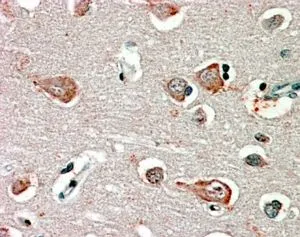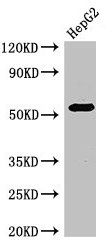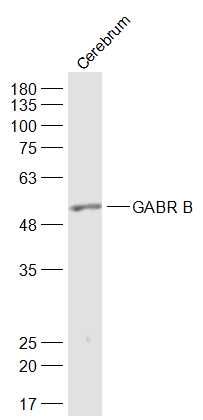
IHC-P analysis of human cortex using GTX31010 GABA A Receptor beta 3 antibody, Internal. Antigen retrieval : citrate buffer pH 6 Dilution : 2.5microg/ml
GABA A Receptor beta 3 antibody, Internal
GTX31010
ApplicationsImmunoHistoChemistry, ImmunoHistoChemistry Paraffin
Product group Antibodies
TargetGABRB3
Overview
- SupplierGeneTex
- Product NameGABA A Receptor beta 3 antibody, Internal
- Delivery Days Customer9
- Application Supplier NoteIHC-P: 2-4microg/ml. *Optimal dilutions/concentrations should be determined by the researcher.Not tested in other applications.
- ApplicationsImmunoHistoChemistry, ImmunoHistoChemistry Paraffin
- CertificationResearch Use Only
- ClonalityPolyclonal
- Concentration0.50 mg/ml
- ConjugateUnconjugated
- Gene ID2562
- Target nameGABRB3
- Target descriptiongamma-aminobutyric acid type A receptor subunit beta3
- Target synonymsDEE43; ECA5; EIEE43; GABAA receptor beta-3 subunit; GABA-alpha receptor beta-2 subunit; gamma-aminobutyric acid (GABA) A receptor, beta 3; gamma-aminobutyric acid A receptor beta 3; gamma-aminobutyric acid receptor subunit beta-3; gamma-aminobutyric acid type A receptor beta3 subunit
- HostGoat
- IsotypeIgG
- Protein IDP28472
- Protein NameGamma-aminobutyric acid receptor subunit beta-3
- Scientific DescriptionThis gene encodes a member of the ligand-gated ionic channel family. The encoded protein is one the subunits of a multi-subunit chloride channel that serves as the receptor for gamma-aminobutyric acid, a major inhibitory neurotransmitter of the mammalian nervous system. This gene is located on the long arm of chromosome 15 in a cluster with two other genes encoding related subunits of the family. This gene may be associated with the pathogenesis of several disorders including Angelman syndrome, Prader-Willi syndrome, nonsyndromic orofacial clefts, epilepsy and autism. Alternatively spliced transcript variants encoding distinct isoforms have been described. [provided by RefSeq, Jul 2013]
- Storage Instruction-20°C or -80°C,2°C to 8°C
- UNSPSC12352203






